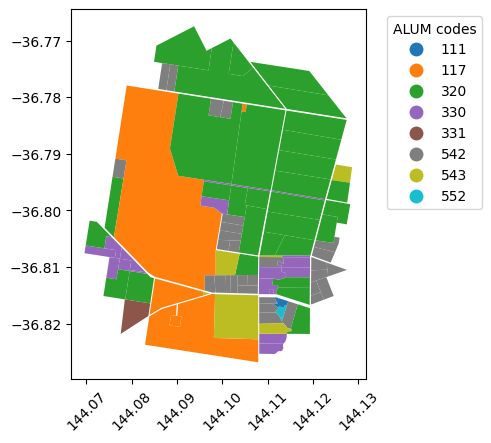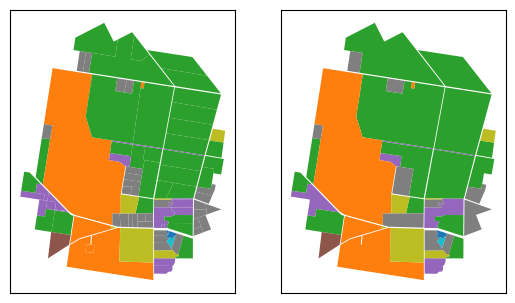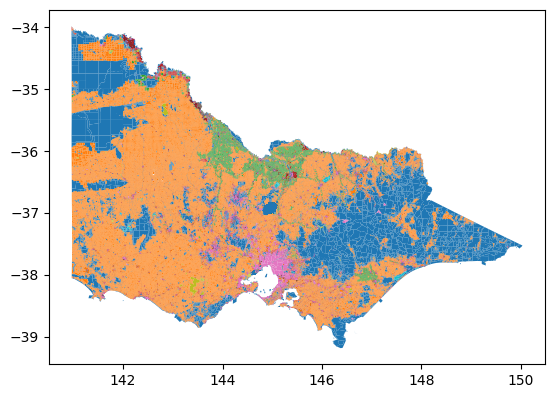import psycopg
from sqlalchemy import create_engine
# database configuration
user = '<username>'
host = 'localhost'
database = '<dbname>'
driver = 'postgresql+psycopg'
connection_str = f'{driver}://{user}@{host}/{database}'
engine = create_engine(connection_str)Do you have a large GIS dataset where you want to effeciently dissolve all adjacent polygons with the same attribute? In this post, I will share how I achieved that using PostGIS on a landuse dataset with > 750k rows of data.
I will use the Victorian landuse dataset as an example. This data is freely available from Data VIC. The examples below are shown using the jupysql extension for JupyterLab. In this dataset, each parcel of land is assigned an ALUM (Australian Land Use and Management Classification) code. Read more about ALUM codes here.
The Motivation
First, let’s plot a small sample set of the data using geopandas in Python, so I can explain my motivation for wanting to dissolve the polygons.
Since the data is saved in a PostGIS table, we’ll first create a connection to the database.
I only want to sample subset of the data, so I’ll filter only Polygons within 0.025 degrees of a random location (-36.8, 144.1).
import geopandas as gpd
sql = """
SELECT alumv8, geometry
FROM vic_landuse
WHERE ST_DWithin(geometry,
ST_GeomFromText('POINT(144.1 -36.8)', 7844), 0.025)
AND ST_geometrytype(geometry) = 'ST_Polygon'
"""
sample = gpd.read_postgis(sql, engine, geom_col="geometry")
sample['alumv8'] = sample['alumv8'].astype('category')
ax = sample.plot(
'alumv8',
legend=True,
legend_kwds=dict(loc='upper left', bbox_to_anchor=(1.05, 1), title='ALUM codes')
)
ax.tick_params('x', rotation=45)In the above map, we have many adjacent land parcels with the same attribute (alumv8 in this case). I want to create custom tiles based on land use; so I’m not interested in individual parcels of land. For processing purposes, it makes sense for me to reduce the number of geometries by merging adjancent polygons with the same attribute.
Demonstration using a subset
First, I will demonstrate how I achieved this in a step-by-step manner using the small subset dataframe I created above. Then we can create a script to automate the process for the entire table.
%load_ext sql
%sql postgresql+psycopg://<username>@localhost/<dbname| Config | value |
|---|---|
| style | MARKDOWN |
| feedback | 0 |
| displaycon | False |
I’ll create a new table with the sample data
%%sql
CREATE TABLE
sample_landuse AS
SELECT
*
FROM
vic_landuse
WHERE
ST_DWithin (
geometry,
ST_GeomFromText ('POINT(144.1 -36.8)', 7844),
0.025
)
AND ST_geometrytype (geometry) = 'ST_Polygon'%%sql
SELECT
alumv8,
COUNT(alumv8)
FROM
sample_landuse
GROUP BY
alumv8;| alumv8 | count |
|---|---|
| 552 | 2 |
| 330 | 18 |
| 320 | 30 |
| 117 | 5 |
| 543 | 6 |
| 331 | 1 |
| 542 | 30 |
| 111 | 2 |
The process I followed is: 1. create a view for each ALUM code. 1. within each code, dissolve geometries if they are adjacent, which results in a separate table. 1. concatenate all tables created in step 2. 1. cleanup any intermediary views and tables.
I will demonstrate each step with an example below.
Create a view for each ALUM code
This is quite simple. In this case, let’s use ALUM code 320.
%%sql
CREATE VIEW
landuse_320 AS
SELECT
*
FROM
sample_landuse
WHERE
alumv8 = 320;Dissolve adjacent geometries within each code
The ST_ClusterDBSCAN is a window function that returns a cluster number for each input geometry. Geometries that are adjacent to each other are given the same cluster number.
We’ll use ST_ClusterDBSCAN(geometry, 0, 2) because we want to cluster geometries within 0 units (degrees) of each other and we want at least two geometries in the cluster.
%%sql
CREATE TABLE
landuse_320_clustered AS
SELECT
alumv8,
ST_ClusterDBSCAN (geometry, 0, 2) OVER () AS cluster_id,
geometry
FROM
landuse_320;We can see that several clusters have been created with at least 2 polygons.
%%sql
SELECT
cluster_id,
COUNT(cluster_id)
FROM
landuse_320_clustered
GROUP BY
cluster_id
ORDER BY
COUNT desc
LIMIT
5;| cluster_id | count |
|---|---|
| 1 | 4 |
| 0 | 4 |
| 7 | 4 |
| 2 | 3 |
| 4 | 2 |
%%sql
CREATE TABLE
landuse_320_dissolved AS
SELECT
alumv8,
ST_Union (geometry) AS geometry
FROM
landuse_320_clustered
GROUP BY
alumv8,
cluster_id;Now, we have only 10 polygons instead of the 30 we originally started with.
%%sql
SELECT
COUNT(*)
FROM
landuse_320_dissolved;| count |
|---|
| 10 |
Repeat for all ALUM codes
Now, we can loop through all ALUM codes in the table and repeat the above process for each code.
%%sql
DROP VIEW IF EXISTS landuse_320;
DROP TABLE IF EXISTS landuse_320_clustered;
DROP TABLE IF EXISTS landuse_320_dissolved;
DO $$
DECLARE
alum_code int;
BEGIN
-- the new table
CREATE TABLE landuse_dissolved (alumv8 int, geometry geometry);
FOR alum_code IN
SELECT DISTINCT alumv8 FROM sample_landuse
LOOP
EXECUTE format('DROP VIEW IF EXISTS landuse_%s', alum_code);
-- create view for the code
EXECUTE format('
CREATE VIEW landuse_%s AS
SELECT * FROM sample_landuse
WHERE alumv8 = %L',
alum_code, alum_code);
-- create clustered table
EXECUTE format(
'CREATE TABLE landuse_%s_clustered AS
SELECT
alumv8,
ST_ClusterDBSCAN(geometry, 0, 2) OVER() AS cluster_id,
geometry
FROM landuse_%s', alum_code, alum_code
);
-- dissolve adjacent geometries
EXECUTE format(
'CREATE TABLE landuse_%s_dissolved AS
SELECT alumv8, ST_Union(geometry) as geometry
FROM landuse_%s_clustered
GROUP BY alumv8, cluster_id',
alum_code, alum_code
);
-- add dissolved geometries to new table
EXECUTE format('
INSERT INTO landuse_dissolved (alumv8, geometry)
SELECT alumv8, geometry
FROM landuse_%s_dissolved', alum_code
);
-- cleanup intermediary views and tables
EXECUTE format('DROP TABLE landuse_%s_clustered', alum_code);
EXECUTE format('DROP VIEW landuse_%s', alum_code);
EXECUTE format('DROP TABLE landuse_%s_dissolved', alum_code);
COMMIT;
END LOOP;
END $$original_rows = %sql SELECT COUNT(*) FROM sample_landuse;
new_rows = %sql SELECT COUNT(*) FROM landuse_dissolved;
print(f"original_rows = {original_rows[0].count}")
print(f"rows after dissolving = {new_rows[0].count}")original_rows = 94
rows after dissolving = 29So, after dissolving adjacent polygons, we’re down to 29 polygons from the original 94. Now let’s plot the dissolved table landuse_dissolved next to the original sample table and visually inspect the impact of the abvove process.
import matplotlib.pyplot as plt
sql = "SELECT * FROM landuse_dissolved"
sample_dis = gpd.read_postgis(sql, engine, geom_col="geometry")
sample_dis['alumv8'] = sample_dis['alumv8'].astype('category')
fig, (ax1, ax2) = plt.subplots(1, 2, sharey=True)
sample.plot('alumv8', ax=ax1)
sample_dis.plot('alumv8', ax=ax2)
for ax in [ax1, ax2]:
ax.set_xticks([])
ax.set_yticks([])We can see that no information has been lost, except for individual land parcel boundaries for adjacent geometries with the same ALUM codes. Thus, we can confirm that we have the desired results and can now proceed with doing the same for the entire dataset.
Area is less?
One thing to note here is that the total area will be less than the original. This is mostly due to the simplification of geometries during the dissolve process, or the elimination of overlapping areas among the polygons.
Let’s calculate the total area of each ALUM code and compare the results for both tables.
Note: Since the CRS of the geometry is geographic (EPSG:7844, whose unit is degrees), we’ll transform the geometry to the corresponding planar CRS (EPSG:3111, whose unit is in metres) for calculating the area.
%%sql
original_area <<
SELECT
alumv8,
SUM(ST_Area (ST_Transform (geometry, 3111))) AS area
FROM
sample_landuse
GROUP BY
alumv8;%%sql
new_area <<
SELECT
alumv8,
SUM(ST_Area (ST_Transform (geometry, 3111))) AS area
FROM
landuse_dissolved
GROUP BY
alumv8;We can create a dataframe with the difference in area in sq. metres. Turns out 77 out of 123 ALUM codes have some difference in their total area.
area= original_area.DataFrame().set_index('alumv8').join(new_area.DataFrame().set_index('alumv8'), how='inner', rsuffix='_new')
area['diff'] = area['area'] - area['area_new']
area['diff_pct'] = 100 * (area['area'] - area['area_new']) / area['area']
area| area | area_new | diff | diff_pct | |
|---|---|---|---|---|
| alumv8 | ||||
| 111 | 3.552145e+04 | 3.552145e+04 | 0.000000e+00 | 0.000000e+00 |
| 117 | 7.232697e+06 | 7.232697e+06 | 9.313226e-10 | 1.287656e-14 |
| 320 | 1.201683e+07 | 1.201683e+07 | 3.725290e-09 | 3.100060e-14 |
| 330 | 1.191974e+06 | 1.191974e+06 | 6.984919e-10 | 5.859962e-14 |
| 331 | 2.330225e+05 | 2.330225e+05 | 0.000000e+00 | 0.000000e+00 |
| 542 | 1.928476e+06 | 1.928476e+06 | -1.164153e-09 | -6.036648e-14 |
| 543 | 1.174942e+06 | 1.174942e+06 | 0.000000e+00 | 0.000000e+00 |
| 552 | 3.209726e+04 | 3.209726e+04 | -7.275958e-12 | -2.266847e-14 |
We can see that the area is different for 5/8 ALUM codes. While the difference is miniuscle for this sample dataset, the differences can add up when we have a large dataset.
Therefore, it is important to keep this in mind when deciding whether this kind of dissolving is appropriate for the task at hand.
Dissolving adjacent polygons in the entire dataset
Dissolving all adjacent polygons with the same ALUM8 code for the entire dataset of >750k rows is, of course, an expensive and time consuming process. A short coffee break, or some stretching perhaps?
But the results are quite impressive. I ended up with only ~ 112k rows, a reduction of 85%.
original_rows = %sql SELECT COUNT(*) FROM vic_landuse;
new_rows = %sql SELECT COUNT(*) FROM vic_landuse_dissolved;
print(f"original_rows = {original_rows[0].count}")
print(f"rows after dissolving = {new_rows[0].count}")original_rows = 751295
rows after dissolving = 112603import geopandas as gpd
import matplotlib.pyplot as pltWe can immediately see the difference in certain tasks such as plotting with the reduced number of rows. Plotting the original dataset with geopandas takes ~2 minutes on my computer, whereas only ~50s is needed for the dissolved dataset.
sql = "SELECT * FROM vic_landuse"
vic_landuse = gpd.read_postgis(sql, engine, geom_col="geometry")
vic_landuse["alumv8"] = vic_landuse["alumv8"].astype("category")


